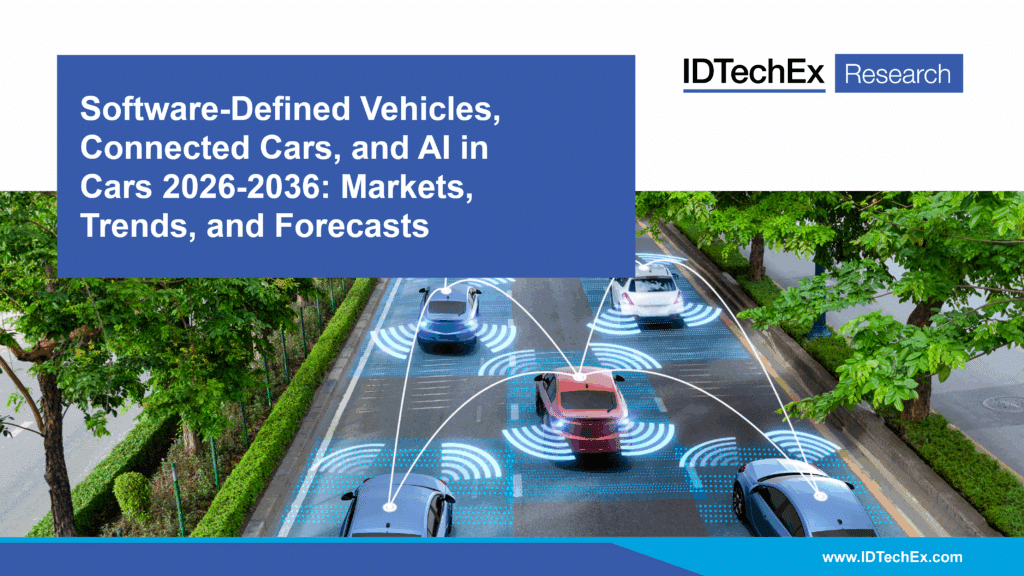For more information, visit https://www.idtechex.com/en/research-report/software-defined-vehicles-connected-cars-and-ai-in-cars/1108.
SDV Central compute will hit US$755B by 2029; SDV feature revenue will grow 34% CAGR by 2035.
The automotive industry is undergoing a foundational shift toward software-defined vehicles (SDVs), where functionality, value, and user experience are increasingly governed by software rather than hardware. IDTechEx’s report, “Software-Defined Vehicles, Connected Cars, and AI in Cars 2026-2036: Markets, Trends, and Forecasts”, offers a comprehensive analysis of this transformation, covering the evolution of in-vehicle electrical/electronic (E/E) architecture, connectivity platforms, feature monetization models, and long-term market forecasts. According to IDTechEx forecasts, Central Compute and quasi-zonal SDV platforms are set to generate around US$755 billion in hardware revenue by 2029, becoming the key source of value uplift for OEMs. SDV feature-related revenue is expected to grow at a 30-34% CAGR through 2035, driven by connectivity and autonomy-based service monetization.
 Global total vehicle sales by SDV level.
Global total vehicle sales by SDV level.
From ECUs to Central Compute: The Rise of SDV Architectures
Modern SDVs are defined by their ability to decouple hardware from software, supported by centralized computing platforms and over-the-air (OTA) update capabilities. This report classifies SDVs across five levels, from gateway-centric and domain-based systems to fully software-centric vehicles and provides a detailed breakdown of the key enabling components, including high-performance compute (HPC), zonal controllers, and service-oriented middleware.
The report analyzes flagship platforms such as BMW’s Neue Klasse, Tesla’s FSD-capable models, and emerging Chinese SDVs from BYD, NIO, and Li Auto. It also explains how these vehicles use technologies like TSN Ethernet, AI-enabled SoCs, and solid-state power distribution to reshape the EE landscape.
Monetization in the SDV Era: Features-as-a-Service and In-Vehicle Commerce
SDVs are not only a technical upgrade, they represent a shift in the business model. Automakers are increasingly embedding monetizable features in the vehicle, ranging from advanced driver assistance systems (ADAS) to infotainment, personalization, and even heating functions.
The report outlines how OEMs like BMW, Ford, and Mercedes-Benz are leveraging features-as-a-service (FaaS) and OTA updates to generate recurring revenue. It investigates subscription models, regional pricing strategies, and the impact of SDV features on customer retention and brand differentiation.
Case studies highlight real-world deployments, including BMW’s Neue Klasse, and in-car payment platforms powered by Mastercard and JPMorgan Mobility Payments.
V2X Connectivity and Infrastructure Readiness
As vehicles become more autonomous and connected, V2X (Vehicle-to-Everything) technologies play an essential role in ensuring safety, coordination, and enhanced user experience. This report provides a deep dive into C-V2X, DSRC, and 5G-based communications, evaluating their performance, cost, and geographic adoption.
IDTechEx maps spectrum allocations and policy developments across key regions including China, the EU, the US, Japan, and South Korea. The report also profiles major V2X hardware providers and explains how onboard units (OBUs), roadside units (RSUs), and chipsets are integrated into SDV platforms.
Generative AI and the Intelligent Cabin
The report also explores the integration of generative AI in SDVs, particularly in in-car assistants, personalized infotainment, and predictive diagnostics. With companies like Qualcomm, Nvidia, and Unity enabling on-device AI inference, new opportunities are emerging for OEMs to offer adaptive and immersive digital experiences.
Beyond voice control, the SDV cockpit is becoming a digital platform. Full-width screens, AI avatars, and customizable software skins are creating a new battleground for brand loyalty and user engagement.
Forecasts to 2036: SDV Adoption and Revenue Outlook
This IDTechEx report provides 10-year market forecasts on the SDV market for the period 2026-2036, in both volume and market value. Forecasts include:
- Global SDV unit sales by architecture level (SDV-0 to SDV-5)
- Hardware revenue by SDV architecture, including central and zonal compute platforms
- Feature-related revenue growth driven by subscription and OTA models
- V2X radio access technology adoption by region
- V2V/V2I Vehicle Unit Sales Forecasting
By 2029, quasi-zonal SDV platforms are forecast to reach US$755 billion in hardware revenue, while feature-based monetization could grow at a 30-34% CAGR, reaching hundreds of billions in cumulative revenue by 2035.


